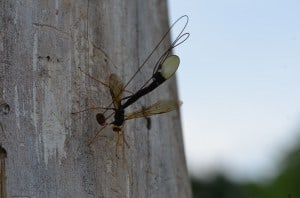I want to share some pictures of a parasitic wasp that I took up near Kinmount. I haven’t been able to identify it, but this animal was about 3-4 cm long and had two ovipositors, each about 10 cm long. When I found it, it was busily probing a hole in a dead elm tree, presumably for some unfortunate insect larva on which it could lay its eggs. I watched it for several minutes and it reminded me of how Chimpanzees use sticks as tools to extract termites from termite mounds. She seemed to be methodically probing the inside of the hole in the tree. I hope you find these pictures as fascinating as I do.
Michael Doran
(Note: I believe that the wasp is a female Megarhyssa atrata lineata (Black Giant Ichneumon) . Click here for more information and pictures. Female ichneumon wasps find a host and lay an egg on, near, or inside the host’s body. Upon hatching, the larval ichneumon feeds either externally or internally, killing the host when it is ready to pupate. Despite looking formidable, the ovipositor does not deliver a sting like many wasps or bees. It can be used by the wasps to bore into and lay eggs inside rotten wood. Ichneumons represent a fascinating story of evolution and how animals do whatever is necessary to reproduce – human sensitivities be damned! D.M.)
